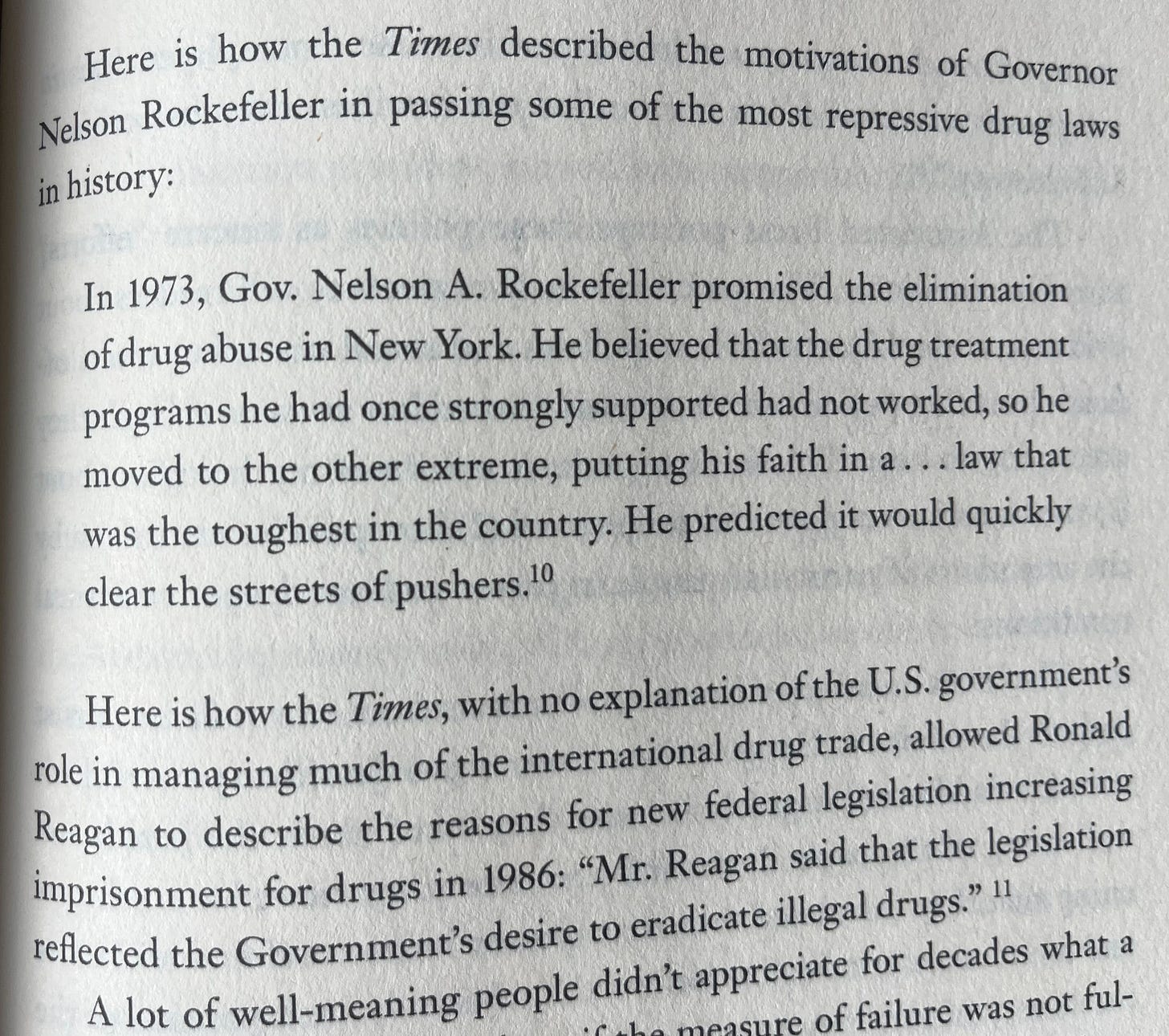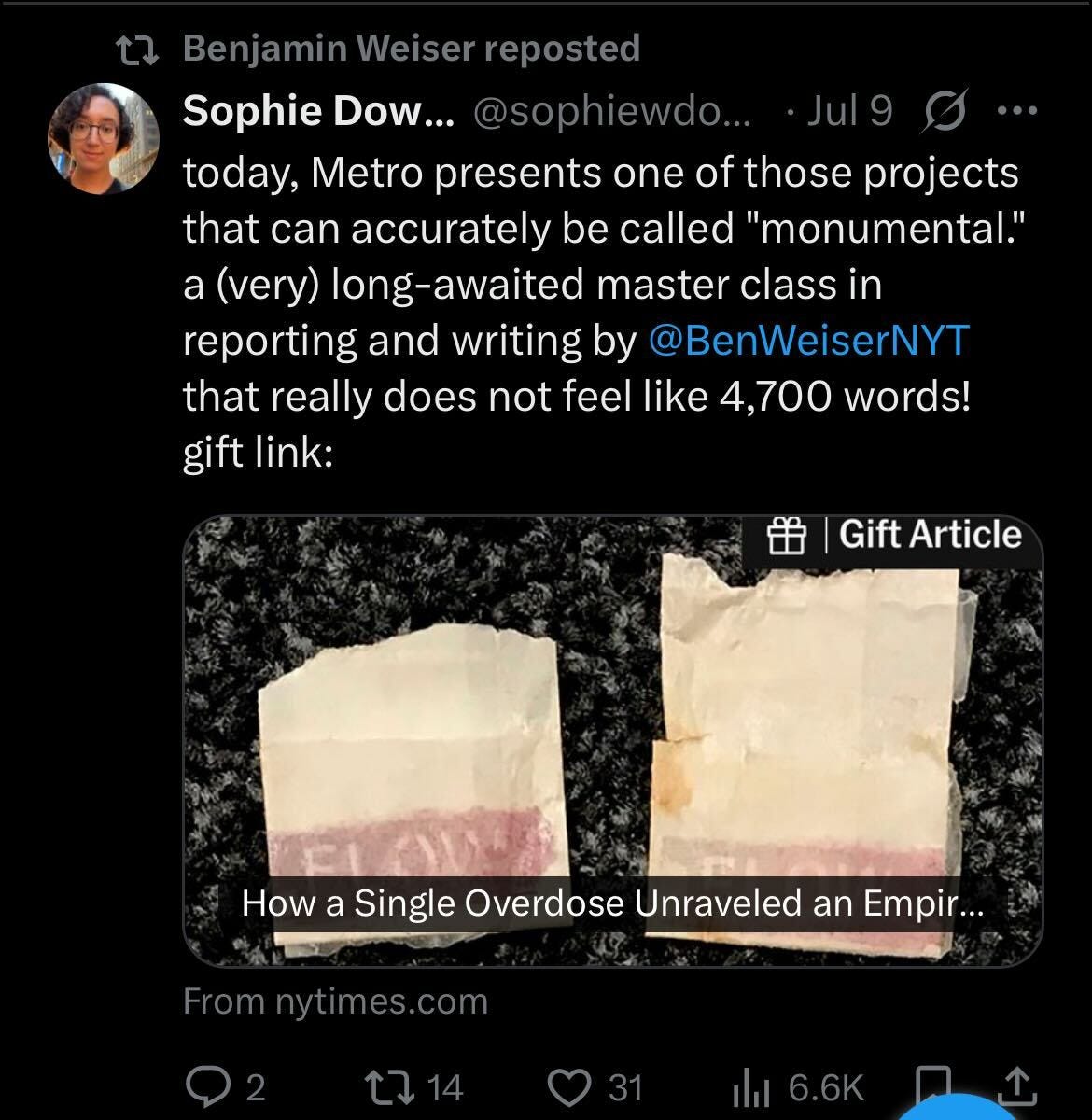Copaganda and Authoritarianism
A few months ago, I was asked to give a TED-style talk in San Francisco about our civil rights work. Since Barack Obama was speaking after me, the audience was more of a mainstream audience than the kind of people who voluntarily subject themselves to my speeches. It was a good opportunity for me to address how the acceptance, normalization, and even celebration of certain lies by elite liberal institutions lays the groundwork for authoritarianism. I hope you’ll consider watching the short video before reading on:
As I suggest in the video, our civil rights work is about many things, including getting as many people as we can out of cages. But the work we do in courts and jails across the U.S. is also about something else: it’s about ensuring that, no matter what kinds of grotesque stuff starts to become normalized in a society that imprisons Black people 6 times the rate of South Africa at the height of Apartheid and all people 5-10 times other comparable countries, there are always people prepared to say “2+2=4.” The moment people stop saying this, everything is lost.
One reason various institutions are crumbling and the people in charge of them so unpopular is that the material reality they defend is so different from their own professed values. They claim to value the “rule of law” but only enforce some laws against some people some of the time. They claim to value “public safety” but pursue policies that make most people less safe. They claim to value liberty but jail hundreds of thousands of society’s poorest people solely because they lack access to cash. They claim to value equality but ensure a small number of people control nearly every major decision. They claim to value evidence but pursue policies that defy evidence. They claim to value health but let us all be regularly poisoned and then destroy the opportunity for most people to get quality health care. They claim to value merit but ensure that fealty to power is what gets rewarded in elite institutions. As a result, establishment politicians, university presidents, and pundits are constantly speaking gibberish instead of being real with people.
Today, I want to focus on one example out of thousands: the way the news media lies about the intentions of powerful institutions in waging the War on Drugs. I cover this in more depth in the Big Deception chapter of Copaganda. I think it is the most important chapter in the book, and the one I am most proud of. It’s also the most expansive and theoretical chapter.
The Big Deception: July 2025 Edition
This week, the New York Times published a hagiography of a ruthless drug war prosecutor that is a good example of what I cover in the book. The entire article is outrageous (including its glorification of the prosecutor’s apparently cartoonish ethics and meloramatic portrayal of social problems as stories of heroes and villains), but I want to focus on a few points. Here’s the article:
First, something subtle. The below quote is a microcosm of the full article: it contains an assertion, reported as fact, that this prosecutor "was trying to make safer” one of the poorest neighborhoods in New York through mass human caging for drugs.
This statement of fact about her intentions is absurd—the people involved are not stupid; they knew that the War on Drugs/mass incarceration had been disproven by as a means of reducing dangerous drug use or making anyone safer. Exactly the opposite was true: the policies were increasing violence, death, and lots of other suffering. As I explain in the book, everyone involved knows that “safety” was never the point of the War on Drugs! This particular hero almost certainly did not believe that she was going to arrest her way out of an opoiod epidemic. More deeply, as I explain in the Big Deception, even if this elite federal prosecutor was a unicorn who really believed that spending trillions to cage the poorest people in society and separate them from their families for fifty years was the way to solve a drug overdose problem, the emphasis on the intentions of individual people within these bureaucracies is one of the most significant achievements of propaganda. Reporting on the individual intentions of supposedly heroic people within the punishment bureaucracy is dangerous nonsense designed to obscure the structural reasons these systems do what they do and who benefits from it. As I explain in Chapter 14 of Copaganda:
The focus on asserted intentions distracts from why policies persist despite their failure. Drug use was never a problem that powerful institutions addressed urgently because they cared about the health and well-being of all people. It was not a problem they viewed as so threatening that they calculated the extraordinary human and financial costs and found mass criminalization worth it. Instead, the expansion of the machinery of state power and profit amid social and racial inequalities was, in many overlapping ways, the impetus to search for policies like what became the war on drugs. The war on drugs was a solution in search of a problem.
Notice two consequences of this deception. First, because reporting on drugs omits the evidence about costs and benefits of drug enforcement from each individual news story like the Associated Press article, people in power avoid daily confrontation about why their assertions about their own motivations don’t match the evidence. Second, because people are not informed about the institutional benefits of the drug war to certain political, racial, bureaucratic, and financial interests, they don’t develop an accurate theory of why the drug war is still happening. For example, almost no daily news article on the topic discusses the benefits of current drug policies to private prisons, pharmaceutical companies, police unions, the bail bond industry, the multi-billion-dollar carceral telecommunications industry, probation departments, police and prosecutors (who benefit from every law that gives them the power to selectively threaten certain people with punishment), real estate developers, diversion providers, surveillance companies, and business and property owners in gentrifying areas.
Later, we get another gem in the NYT article:
This is a copaganda classic: despite almost exclusively relying on barbaric and disproven policies of mass incarceration for the entire life of this prosecutor, the news portrays the punishment bureaucracy as trying everything it possibly can in good faith to find a solution. This is part of reinforcing the deeper lie about what the punishment bureaucracy’s true purposes are. Mass incarceration is portrayed as something only being done because they are trying so hard to make life better for the poorest communities like the neighborhoods in the Bronx and Vermont that the reporter writes passionately about. There’s no other reason. Nothing to see here! And, tragically, despite the best efforts of all these heroes, it’s “impossible” to solve this problem. Just like homelessness. Or healthcare. As it turns out, a lot of social problems are pretty hard to “solve” with guns, handcuffs, cages, and for-profit insurance companies.
And, it is only by socializing this lie that liberal news can keep making it seem like these problems are intractable despite the best efforts of our most honorable public servants, even though we are never actually trying the solutions supported by evidence. Here are a few examples from my Copaganda book about how the New York Times talked about the good intentions of Nixon, Rockefeller, and Reagan:
It is important for readers to appreciate the propaganda benefit of falsifying the intentions of powerful people and institutions. As I explain:
Why has falsification of intentions been central to propaganda for over a hundred years? It helps to ask two questions: (1) What benefits do people in power get from distorting their motivations? (2) How do people in power benefit from ordinary people misunderstanding the reasons people in power do things?
In general, powerful people in charge of public safety want us to think (1) that the problems of our society aren’t structural; (2) that they share our outrage at these problems; (3) that these problems can be fixed with little tweaks to the existing system rather than radical change; and (4) that they are doing everything they can to fix them. There are many ways powerful institutions benefit from masking their intentions, but one is paramount: it takes attention away from the longer causal chain of reasons for why our society looks the way it does.
People in power benefit from hiding their true motivations in other ways. For one, part of their power lies in them knowing more about how things work than people who might organize against them. They also benefit from distracting the public so that potential opposing forces are unable to determine the most effective opposition strategy. Also, many people might not support the people in power’s true intentions and might reject proposals as being motivated by different intentions, such as, say, generating personal wealth after office. Distortion of intentions by focusing on good-faith policy debate also allows institutions to focus advocacy around informing politicians better rather than overthrowing them. Most basically, falsifying intentions matters for some of the same reasons we care about people’s motivations in our everyday lives: they are good predictors of future behavior. Thus, if people in power can keep the public thinking that they are making decisions based on the best available evidence, it helps prevent the public from being able to predict their future self-serving behavior.
Understanding propaganda’s historical focus on intentions helps us see that, in an unequal and unsafe world that is inconsistent with our values and dreams, it is important to people with power that people without it are distracted from the roots of our problems and uncertain about how to change them. People in power do not want people without power to start thinking about how a world with different social, political, and economic arrangements might be possible.
Deception like this is all the more harmful because, at some point, when you keep telling people you’re trying really hard, but you are never able to solve the problem you identify, you lose their trust. People start to ask: why should I believe what these institutions and these supposedly well-meaning elites are telling me. Maybe these people don’t even believe themselves. This is a foundational problem plaguing our society in a variety of domains.
The Icing on the Cake
The public treatment of the article by NYT editors is revealing. Much of elite American journalism is so focused on a good story with heroes and villains and anecdotes that it forgets its most solemn obligation: you must make sure that the anecdotal stories you choose to grab people’s attention to educate them about a topic, and the way you tell those anecdotes, help to get at, rather than obscure, a deeper truth. Anyone can find an anecdote illustrating anything at any time: the key to great journalism, at least in our contemporary environment (I recommend learning about how the CIA, through a variety of fronts like the Iowa Writers’ Workshop and popular magazines worked to establish this method of storytelling in mainstream journalism), is finding anecdotes that both get a lot of eyeballs and that help people understand the world better. Choosing the wrong anecdotes that mislead the public about what is going on is probably the single greatest feature of contemporary copaganda. The below tweet is a good example of how elite journalists often celebrate the wrong stuff and end up promoting dangerous misinformation. Here’s the reporter of the story re-tweeting a NYT editor raving about the story being “monumental” and a “master class in reporting”:
Where are the heroes now?
The ending of the article can only be described as bizarre. It reflects a deep cynicism in elite liberal institutions. There’s an acknowledgment that no one knows what all this incarceration accomplishes, and a sort of throwing-up-of-the-hands. As if to say: “Well, we tried everything we can, so these problems are just gonna be with us forever.”
In a broader sense, it was hard to know what the case had achieved. Ms. Crowley knew that operators like Mr. Lizardi had grown rich while workers and customers like Roach and Mr. Blanchard were doing time or dead….
As for Ms. Crowley, she has moved on to a new chapter of her legal career, but the destruction opiates wrought in the Bronx and in Rutland is never far from her mind….
In 2021, [her friend] died of an overdose.
“You’re never really free of it,” Ms. Crowley said. “And that’s what’s so sad about Vermont. Vermont is never going to be free of it.”
The failure to include any honest discussion of why the prosecutor and people like her—backed by billions of dollars worth of police, judges, prison guards, and private contractors—were actually using incarceration to target people in Vermont and the Bronx for drugs even though everyone know it wouldn’t solve the problem highlights another one of the article’s key omissions: The article omits what the prosecutor hero is doing now. I went to the website of her corporate firm to find out. Here’s what she says about what she’s doing now:
Here are some of her many clients:
In my essay The Punishment Bureaucracy, which is the most comprehensive thing I’ve written on the topic (it’s the first essay in my first book Usual Cruelty), I demonstrate how the punishment bureaucracy ruthlessly crushes the most powerless people in our society while constructing an elaborate apparatus to essentially immunize the crimes of the powerful. The very common career path for federal prosecutors to train and develop their skills sending the poorest people in our society to cages and then to earn millions achieving leniency for wealthy corporate defendants is one of the most revealing ways to understand the true purposes and effects of the U.S. criminal legal system. All of this, of course, is done with the best intentions.










Thank you for including the video. I am eternally grateful for the work you do to release people from jails. It's utterly pathetic that children have to chalk a sidewalk to communicate with their father.
Thank you, Alec, for your essential work.